By Rachel Mesch
With the 2016 Summer Olympics ready to get underway, we can expect to be dazzled by gorgeous images of the world’s best athletes: gleaming, taut muscles in action, strength and determination fixed in seemingly endless, and endlessly seductive, photographic frames.
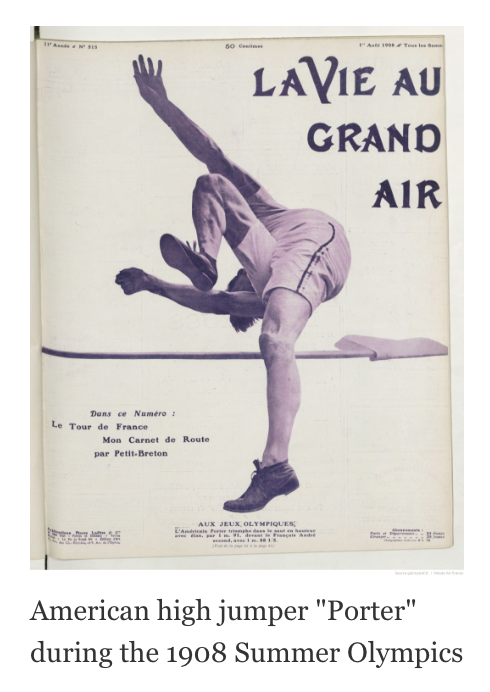 It’s worth pausing for a moment to note how far back this relationship between sports and photography goes—pretty much back to the birth of photojournalism itself. Pierre Lafitte’s La Vie Au Grand Air (roughly translated as “The Great Outdoors”) was the first photographic magazine published in France, in 1898 (that’s a whopping thirty-eight years before Sports Illustrated was born). The very concept of this magazine linked sports to what the camera could capture: it was billed as “an illustrated revue for all sports,” and sought a new market share in the exploding mass press by promising that over half of its material would be composed of images. For the late nineteenth-century reader, the thrill of this new media was very much the thrill of the visual, which offered a more intimate form of access and connection to sports than ever before. With technology improving technology with every issue, readers were provided an eye-catching perspective on athletic events, which they no longer had to attend in order to feel as if they were there. By the time of the summer olympics rolled around in 19
It’s worth pausing for a moment to note how far back this relationship between sports and photography goes—pretty much back to the birth of photojournalism itself. Pierre Lafitte’s La Vie Au Grand Air (roughly translated as “The Great Outdoors”) was the first photographic magazine published in France, in 1898 (that’s a whopping thirty-eight years before Sports Illustrated was born). The very concept of this magazine linked sports to what the camera could capture: it was billed as “an illustrated revue for all sports,” and sought a new market share in the exploding mass press by promising that over half of its material would be composed of images. For the late nineteenth-century reader, the thrill of this new media was very much the thrill of the visual, which offered a more intimate form of access and connection to sports than ever before. With technology improving technology with every issue, readers were provided an eye-catching perspective on athletic events, which they no longer had to attend in order to feel as if they were there. By the time of the summer olympics rolled around in 19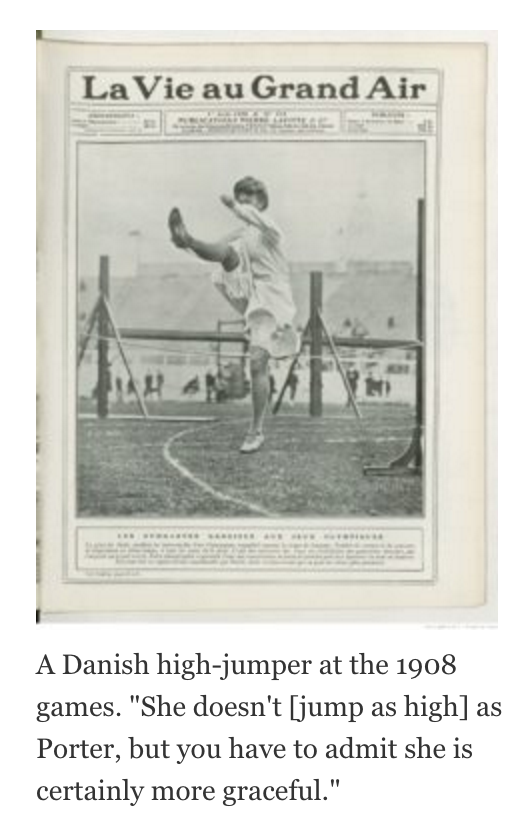 08, the magazine was able to offer stunning action shots, like the one here of American high jumper Porter, impossibly twisted, in mid-air.
08, the magazine was able to offer stunning action shots, like the one here of American high jumper Porter, impossibly twisted, in mid-air.
Just a few years after launching La Vie Au Grand Air, Lafitte came up with another journalistic innovation: to create a photographic magazine for women, directing all of his cutting edge technology and modernizing journalistic tools towards a female readership. Lafitte’s insight into market shares had, once again, everything to do with the visual: his publication, named Femina, quickly surpassed other women’s magazines precisely because it was so much more visually intriguing than, say, the reigning fashion rag, La Mode illustrée. While historians of photography recognize the importance of La Vie Au Grand Air, they have almost entirely overlooked Femina and its photographic innovations. The magazine worked tirelessly to stage a new image of the m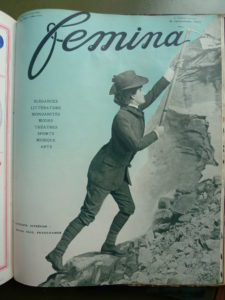 odern woman who could balance work and family, and it harnessed the as yet untapped power of the photograph to make that case as compelling as possible.
odern woman who could balance work and family, and it harnessed the as yet untapped power of the photograph to make that case as compelling as possible.
As an off-shoot of this imagery, Femina also promoted the female athlete as a celebration of modern femininity. Without baring too much of their own musculature, their female athletes seem delighted by their freedom of movement. You can see a slide show of them, as well as some in Femina‘s rival La Vie Heureuse, through this link. They are depicted as gracefu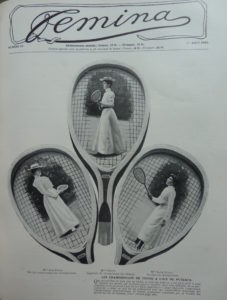 l and lovely, but most of all happy, joyously embracing the thrills of their sport—without breaking a sweat. These early female athletes are forward-moving creatures, decidedly modern with no trace of menace to the social structures they were quietly gliding over and past.
l and lovely, but most of all happy, joyously embracing the thrills of their sport—without breaking a sweat. These early female athletes are forward-moving creatures, decidedly modern with no trace of menace to the social structures they were quietly gliding over and past.
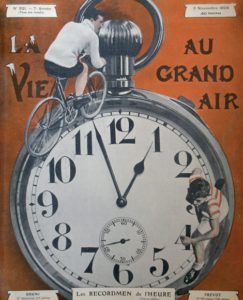 La Vie Au Grand Air delighted in early “photo-shopping” techniques: mixed media cutting and pasting that combined photographs with traditional journalistic artistic tools, pen and ink and watercolor graphic designs. You would think the surrealists were imitating them, fifteen plus years later. Femina often mirrored this fanciful take, all part of an early pleasure in the visual culture of sports, and a subtle acknowledgment of the ways in which our athletes have long defied the laws of physics.
La Vie Au Grand Air delighted in early “photo-shopping” techniques: mixed media cutting and pasting that combined photographs with traditional journalistic artistic tools, pen and ink and watercolor graphic designs. You would think the surrealists were imitating them, fifteen plus years later. Femina often mirrored this fanciful take, all part of an early pleasure in the visual culture of sports, and a subtle acknowledgment of the ways in which our athletes have long defied the laws of physics.
***
You can see more issues of La Vie Au Grand Air on the digital website of the French national library, gallica.fr. For more on Belle Epoque women’s magazines, see my book, Having it All in the Belle Epoque: How French Women’s Magazines Invented the Modern Woman.
